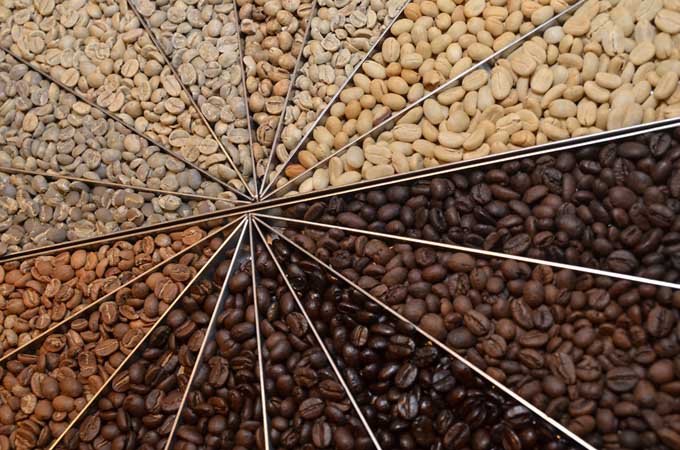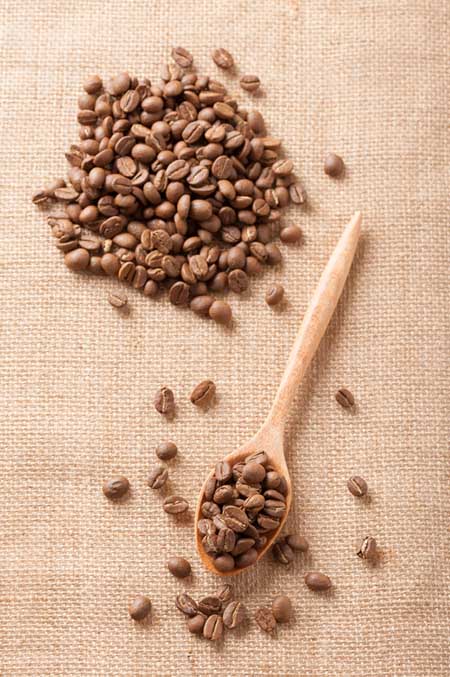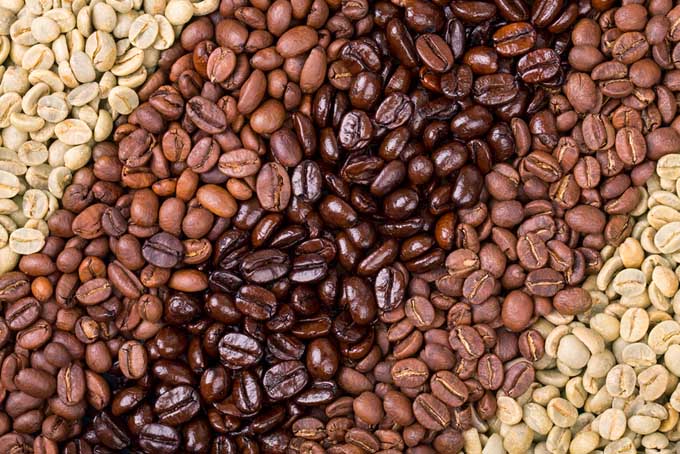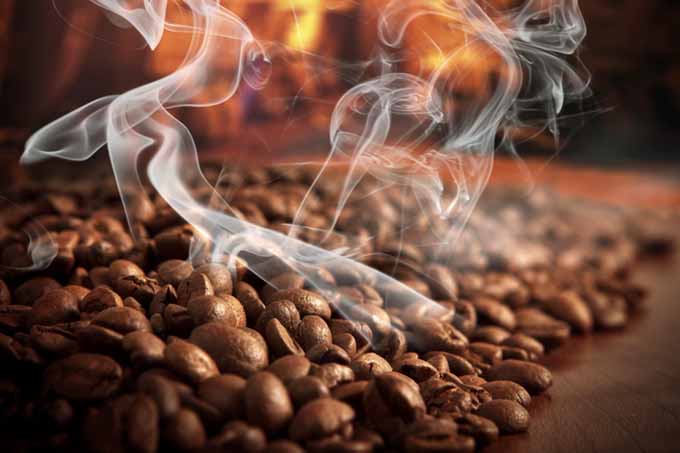There are several factors that go into creating the flavor profile of any particular coffee. The location and environment that a plant is grown in plays a huge role; the type of wash or processing also has a part. However, one of the biggest influences on its essence is the roasting procedure.

This process can completely alter and change the way a cup tastes. Typically, lighter roasts maintain the more prominent characteristics from their region and growing environment, while darker ones take on traits from being roasted, due to the fact that they’re exposed for a more prolonged period of time and advance to higher levels of heat.
There are two main factors that determine a bean’s type of roast: time and temperature. These elements are what determine which class a coffee will fall into.
According to the National Coffee Association (NCA), there are four categories of roast colors and levels: light roasts, medium, medium-dark, and dark. Each of these groups has multiple subcategories within it, which clarify roast levels even further.
Light Roasts
Light roasts live up to their name in being the lightest of the roasted coffees. Only heated for around seven or eight minutes, they are removed shortly after the first crack originates.

At this point, the internal temperature of the bean has reached approximately 350-400ºF. The beans are often a very pale brown and have a very dry surface, since they are not warmed long enough for oils to be released.
More often than not, the coffees categorized here have a milder flavor that reflects its place of origin well. This stage includes common roasts such as Light City, Half City, Cinnamon, and New England.
Medium Roasts
Medium roasts are a slightly deeper brown than their lighter counterparts, due to the fact that they are roasted for nine to eleven minutes and reach an internal temperature of up to 428ºF.
They usually have a fuller body, but are still oil-free on the surface.
Beans in this category include City, American, and Breakfast.
Medium-Dark Roasts
The next stage is medium-dark. As its name implies, it falls somewhere in between the two color phases. These beans have more oils than either of those described previously, because of their 11-12-minute roast time.
As a matter of fact, all darker roasts tend to be oily, thanks to the chemical process that occurs during the more advanced (i.e. hotter) stages of roasting.
Foodal Recommends Koa Coffee Plantation’s 100% Kona Coffee – Hawaiian Espresso Roast
Medium-dark beans reach an internal temperature of up to 450ºF, and have a much more full-bodied taste than lighter roasts. Espresso and Full City are the most common type in this category, and these are my personal preference.
If you’ve only had commercial pre-ground and think you like French roast, I highly encourage you to try a Full City or an espresso roast such as the Koa Coffee espresso roast shown above to get a true taste of what good coffee should taste like.
Dark Roasts
Dark roasts are shiny with oil and are a very dark color—sometimes virtually black. With a 14-minute roast time, these beans typically have a stronger flavor profile than any of their lighter counterparts.
High, Continental, New Orleans, European, Espresso, Viennese, Italian, and French are a handful of the popular subcategories.

The word “charred” is commonly used for this group, based on the fact that these beans are exceptionally well roasted, sometimes reaching upwards of 510ºF. At this stage, virtually no hints of acidity remain and, instead, they often have a slightly bitter taste.
Dark roasts also tend to lack most, if not all, of the original flavors from their cherry. If a bean is heated for too long or the temperature becomes too high, the ideal profile is lost, and it’s left tasting thin and lifeless.
What About Caffeine?
In addition to varying flavor profiles between roasts, caffeine content is also influenced. Studies suggest that lighter roasts retain the highest levels of the popular stimulant, while darker ones preserve the least.
The concept that roast level could have this effect is surprisingly unknown to many coffee-drinkers, who assume that stronger tasting coffee contains more caffeine. Now you know!
Time to Choose
Each consumer will inevitably have a different roast preference, which is why vast variations of coffees are so widely available on the market. So now the question is… which is your favorite?
It may take a little time to experiment with what’s out there, but most coffee connoisseurs do find with time that they have a marked preference for a certain type. Or, they may choose to pair certain varieties with their mood or habits, drinking a dark espresso in the morning, and something brighter and lighter in the afternoon.
Whatever you choose, have fun with it, and enjoy the brew!
About Kate Ackerman
A compulsive list-maker with a profound love for art, the outdoors, good beer, and Star Wars, Kate is a stereotypical Washington native (read: rain-loving coffee addict). And while she calls freelance writing her career, she's often found traveling the world, plunking on pianos, or spending time with her well-loved bulldog.



Now this is my kind of article! I am a purist when it comes to coffee. I like mine very hot, very creamy and very strong. I wasn’t surprised to hear that dark beans with oil showing on them makes for a robust cup. What DID surprise me was finding out that if the beans are roasted TOO long, the flavor can fall flat. That is a tragedy! LOL It was good to read so much detailed info about my favorite brew.
The roasting process is really interesting (and I’ll hopefully be posting more articles on it soon)! But if you’ve ever had a cup of dark coffee that has very little real flavor and just tastes a bit burnt, that’s often the result of over-roasting.
I’m a dark roast girl and always have been. I wondered why coffee tastes bad if it is roasted too long. It’s the same as people reheating coffee; it seems all wrong and never tastes the same or as good. I prefer to make it fresh each time, because it’s all about the flavor and anything reheated never tastes good.
Dark roasts are my favorite besides they have a rich aroma and taste to them, the only problem i find myself encountering, is adding a lot of sugar in my cup, otherwise that coffee will be undrinkable. As for light roasts if mixed in a bag of cashew nuts… one would easily mistake them for cashews…hmmm, {a wonderful prank for April fool’s next year 😉 }
I am most definitely of the dark roast persuasion! That said, I’ve had some dark roasts that are clearly acidic and unpleasant, but I guess that means they’ve been roasted for far too long. Coffee brewed at too high a temperature will cause this acidic taste too.
Some of the lighter roasts definitely lack character for me, but I guess it’s individual taste buds that matter, and some people just can’t take the taste of some of the darker roasts. But even the addition of cream and sugar won’t cut through that acidic taste if you’re unlucky enough to find yourself with an over-roasted bean.
A lot of times the roasting process (or brewing method) isn’t to blame when it comes to acidity; it’s actually the bean itself and the region where it’s grown. Most Latin American cultivars have higher levels of acidity while examples that come from Africa will have more of a rich, earthy flavor. Most bags of beans are labeled with the region in which they’re grown. So if you’re wanting to find a less-acidic beverage, I’d suggest avoiding anything that comes from Guatemala, Peru, etc.!
My experience is that African coffees are even more acidic than Central American. While Asian and South Amercian (Brazilian) are the ones with the least amount of acid.
Very interesting! I have never really paid attention about the different kinds of roasts in coffee. I usually drink a medium-dark. I’ll consider buying some other varieties in the future.
I suppose my preference (based on this) would be the ‘charred’. I like my coffee straight. So I’m fine without the whole cream & sugar bit. It helps when it’s darker for some reason.
Coffee has never been an essential part of my morning. I just need a shower to complete my waking up process. But for those late night studying, I sometimes order an ice coffee to keep me awake and going until an afternoon nap appears. I have always enjoyed the smell of coffee in the cute little shops, but never been an avid drinker of the dark, mysterious brew. We often keep a distance between us two, since we aren’t really agreeing any time soon.
Coffee is one of my favorite things to drink in the morning and after dinner. I was not aware that the lighter roasts have the most caffeine content. I have always thought the darker roasts to contain the most caffeine. Maybe this is why I’m not as juiced up in the morning! Dark roast is the favorite in my household. A large cup of dark roast with a small amount of cream and sugar is just what I need to get my day started!
I think that the majority of people assume that the darker examples have a higher level of caffeine. People usually correlate “stronger” with “more caffeine.”
Yes, as stated, I also thought darker equated to stronger, meaning more caffeine, and had considered trying out a lighter blend, to decrease the caffeine. Apparently, what I actually need to do is stick with my preferred dark roast, but look for beans that are from Africa, instead of Latin America. That is definitely good to know, since I need to decrease the acidity in my coffee. Great article, thanks for sharing this information!
This may seem a bit blasphemous , however I like to make a confetti roast. I start with roasting some beans to a light city roast for a nutty flavor. I then roast some beans to city dark and then combine the two before grinding them. I get a wonderful flavor profile and loads of caffeine.
Caffeine content is not affected by roast level. Please stop spreading this mis-information.
This article was published in 2015, and your comment prompted me to dig a little more closely into the research on this claim.
According to a study published in Food Chemistry in 2011, “Light roasted… coffee contained the highest overall content of caffeine among all coffees, which exhibited a decrease with intensified roasting” and the authors found “The content of caffeine decreases with intensified roasting of coffees.” However, somewhat contradictory results were found in a study published in the International Journal of Food Science & Technology in 2011 stating “Caffeine levels were higher in canephora… than in arabica… and increased up to 21% at darker roasts.” A more recent study published in 2018 in the Korean Journal of Plant Sciences found “caffeine content was highest in [medium roast] samples of both [arabica and robusta].” Based on the contradictory evidence presented here and a lack of repeated, clear research in recent years, it would seem the jury is still out on this one. It is clear that roasting levels can have an effect on caffeine content. Whether or not these results are consistent remains to be seen. Overall, since coffee is a natural product, caffeine content can be affected by growing conditions. Processing may also have a significant affect, and this may vary from bean to bean.